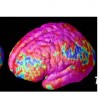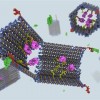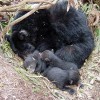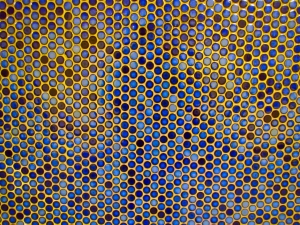When is a clone not a clone? When it’s a mosaic.
For the last decade or so, progressive cancer treatments involved taking samples of tumors, testing the cells to determine the genetic makeup, and then prescribing medicines targeted to specific mutations. There are many benefits to this approach, but it doesn’t always work.
It turns out that tumors aren’t uniform; they are mosaics of cells that can be genetically very different. A recent paper in the New England Journal of Medicine showed that a cell in one area may not be the same as a call in another area (a phenomenon called “intratumor heterogeneity”). So a treatment based on a sample from one area may not work for the whole tumor. Some tumor cells may be resistant to the drug so the cancer persists, or even grows.
In this British pilot study, cells from 9 different locations within a primary kidney tumor, and several metastatic tumors, were analyzed using next generation DNA sequencing. Only 34% of the 118 mutations identified were present in all the samples, and several of the major cancer genes were mutated in different ways in different locations. This turned traditional ideas about cancer cells being “clones” of a single, mutated cell on its head.
Previously, it was thought that a tumor develops when a single cell accumulates sufficient mutations over time that eventually lead to it dividing uncontrollably. Therefore if you could find the original mutation, and target treatment to that, then every cell would react to the treatment. But if the tumor is made up of a mosaic of cells, then they could all react differently to the drug. The researchers then created a phylogenetic “tree,” identifying which cells were more persistent, being in the trunk of the tree. They proposed that if those cells were receptive to a targeted medicine, the treatment might be more effective; if not, less so.
Although this study only involved four patients, the results provide a new way of thinking for researchers and clinicians. If we remove the presumption that all tumor cells are identical, we open the way for more creative thinking about how to tackle the problem.
| Print article | This entry was posted by Amy Nisselle on April 27, 2012 at 3:14 pm, and is filed under Inside Cancer. Follow any responses to this post through RSS 2.0. You can leave a response or trackback from your own site. |
No comments yet.
No trackbacks yet.

Jumping Down the Road to Cancer.
about 12 years ago - No comments
Lying dormant in our genomes are millions of jumping genes. Originally discovered by Barbara McClintock, transposons are DNA sequences that can move from one location to another in our DNA. Transposons cause mutations when they jump to new locations, so keeping them from jumping is important. However, although transposons are largely silent, every person probably…

Jumping genes in your brain?
about 13 years ago - No comments
Mobile chunks of DNA that walk their way from one position in the genome to another may affect neurological diseases and could have subtle influences on normal brain function and behavior, according to a recent study in Nature. Alu is an example of a so-called “jumping gene” – a transposable DNA sequence that “reproduces” by…

A new superdrug that fights pneumonia, pimples AND schizophrenia? Meet Minocycline.
about 13 years ago - No comments
A cheap drug called Minocycline, which is normally prescribed for pneumonia and acne will be tested in a new trial to reduce the symptoms of psychosis in patients suffering from schizophrenia. Schizophrenia is a mental disorder characterized by a breakdown of thought processes and by poor emotional responsiveness. According to the WHO the disorder affects…

Guts against Diabetes
about 13 years ago - No comments
For a very long time I have been using Diabetes as an example of a disorder that is caused by a mutation in the insulin gene. This mutation would stop the cells from making insulin, and a diabetic might need daily insulin injections to regulate their sugar levels properly. I don’t know what took me…

Future Nobel Prize-winning cancer researchers?
about 13 years ago - No comments
What did you do for your science fair this year? Or last year? Or 20 years ago? Recently three high school students took out top honors in science fairs for their projects involving cancer research: Angela Zhang from California developed nanotechnology to destroy cancer stem cells and win the 2011 Siemens Competition in Math, Science…

Exhausting Our Lungs
about 13 years ago - No comments
I have often wondered what impact the diesel fumes from yellow school buses might have on students. I know that I don’t like driving behind those buses because the fumes don’t smell good, so it seemed to me that there might be some health consequences. Others have wondered, too, and there is evidence that…

DNA sequencing helps discover cavemen’s tools and diet
about 13 years ago - No comments
In the 1970s a team of archaeologists led by Carl Gustafson unearthed the remains of a single, 3-ton, male mastodon (Mammut americanum, a close relative of mammoths and elephants), hunted and butchered by a group of men at the Manis site in the state of Washington, USA (Gustafson 1979). Among the mastodon remains they found…

Evolution – Got Milk?
about 13 years ago - No comments
After asking students during a lesson on mutations if it is possible that a mutation in DNA could be good, most students will nod yes without much understanding. Recently, I finally had one student raise his hand immediately and answer the question (with extreme surprise that no other students were blurting out the answer)…”evolution!” He…

What do you get when you cross an immunologist, a nanotechnologist, and a geneticist? A DNA nano-robot!
about 13 years ago - No comments
Welcome to the world of nanobiotechnology and translational research… In a brilliant example of multidisciplinary research, Harvard Medical School’s Shawn Douglas, Ido Bachelet, and George Church combined forces to build nanostructures that would mimic the body’s immune system to recognize cancer cells and trick them into self-destructing. Their research is published today in Science but…

Hibernation – Why Not Me?
about 13 years ago - No comments
It’s the season of hibernation, something I’ve always wished I could do. Oh, to wrap up in a ball, sleep away the winter, and wake to a beautiful spring day – like Bambi! Although the thought has always intrigued me, it never really occurred to me what a feat hibernation actually is. It turns out…

